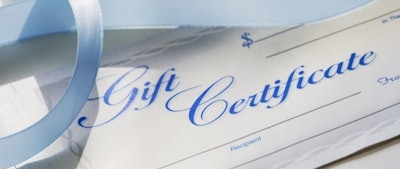Make sure you’re clear on how to profit from gift card sales—before the holidays hit.
 Getty Images
Getty ImagesGetty Images
In 2014, gift card sales in the U.S. reached $124 billion, and spas sell plenty of them. However, just selling the cards won’t pave the way to success; you need some strategies in place to ensure that these sales result in long-term gains for your business.
It’s important to understand that gift card sales aren’t the same as revenue. Yes, you have the money in your bank account, but for accounting purposes, it’s a liability on your balance sheet. It doesn’t become your money until that gift card recipient receives a service or product at your spa and uses the card to pay for it. Then you can recognize the revenue on your income statement. This is true whether you operate under an “accrual” or a “cash” accounting method.
For this reason, accountants advise business owners to keep gift card sales money in a separate escrowed account, and to draw on that account as the cards are redeemed. And that redemption can take a while. In the past, cards could be issued with a one-year expiration, which enabled spas to declare the unredeemed cards as revenue at that point. Today, most states prohibit any expiration date on gift cards, so businesses have to carry that liability on their balance sheets for extended periods.
Because the client redeeming a gift card as payment for a treatment isn’t paying cash, you’ll want to turn to your escrow account to fund the technician’s commission on that sale. Given the non-cash nature of gift card treatments, it would be ideal if spas could meter the redemptions of gift cards, but this proves difficult to put into practice. Unlike the airlines, spas don’t ask callers how they plan on paying for their treatments before booking their appointments. So the more gift cards you sell, the higher your percentage of non-paying clients can be on a particular day, especially weekends.
The Benefits of Dollar-Value Cards
Back in the 1980s, spas mainly sold gift certificates—often handwritten—that were specifically redeemable for a “massage” or a “manicure.” The thinking was that purchasers didn’t want recipients to know how much money they had spent on the gift. Today, because spa operations’ software systems handle gift card sales, we’re witnessing the rise in popularity of the other type of gift card: the dollar-amount card. One benefit of these dollar-amount cards is that the recipient becomes more engaged in reading the spa treatment menu and choosing what appeals to them (and maybe even opting to add on a service that they pay for themselves).
The other clear advantage is that, no matter when a dollar-amount card is redeemed, the spa isn’t obligated to deliver more than its original dollar value, regardless of current menu prices.
Making Gift Card Sales Count
The three biggest gift card sales events of the year are Christmas, Mother’s Day and Valentine’s Day, in that order. However, gift card sales happen each week, and for a multitude of reasons. To spiff up a normally unimpressive-looking gift card, offer packaging options for each holiday, as well as birthdays, anniversaries and general present-giving occasions. Whether a card is tucked inside an envelope, folder, box or some other unique receptacle, the purchaser will enjoy making a personal selection. Some spas also design treatment menus with gift card slots incorporated into them, enabling the gift recipient to browse for options immediately.
Of course, although most special occasions can be planned for, a lot of people still wait until the last minute to purchase their presents. Therefore, having an option on your website to immediately download and print a gift—in this case, a certificate—is key to capitalizing on those last-minute sales. Available through your operating software, this method often includes a few templates for clients to choose from and, more importantly, provides a 24/7 sales option for your business.
It should be noted that relying too heavily on these gift card sales carries some negative side effects for a business. Often, gift recipients are people who “would never come to the spa of their own accord.” When that’s the case, they’re not likely to become regular clients at your spa—and, their appointments take up valuable space that could be used for clients in your target demographic.
It’s also not unusual for a spa staff to put less energy into wooing or retailing to these guests, who, unfamiliar with the spa setting, may be inclined to tip less generously than more frequent guests. Remind your staff that gift card sales deliver prospects rather than clients—and if those prospects are new to your spa, they’ll need even more care and feeding than your regulars. —Lisa Starr











